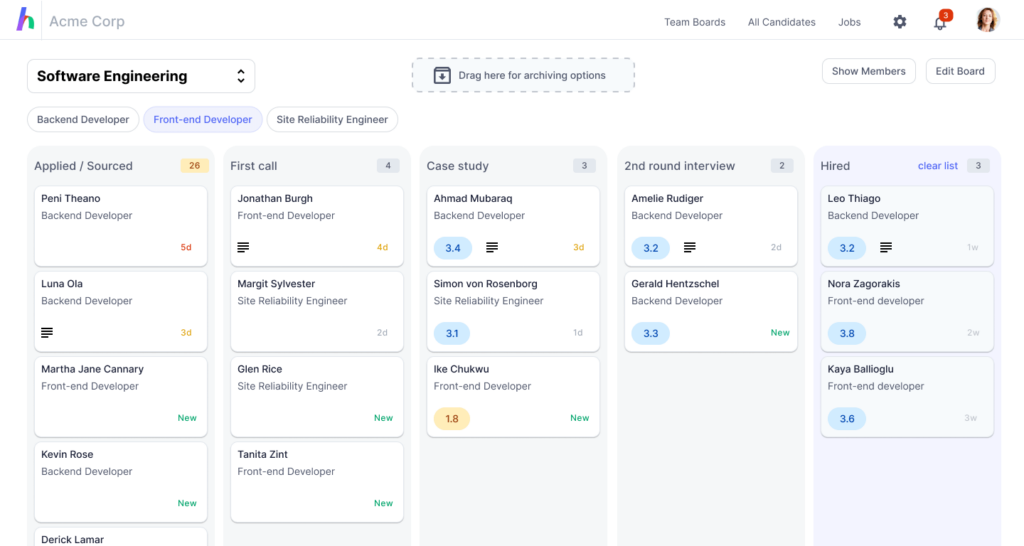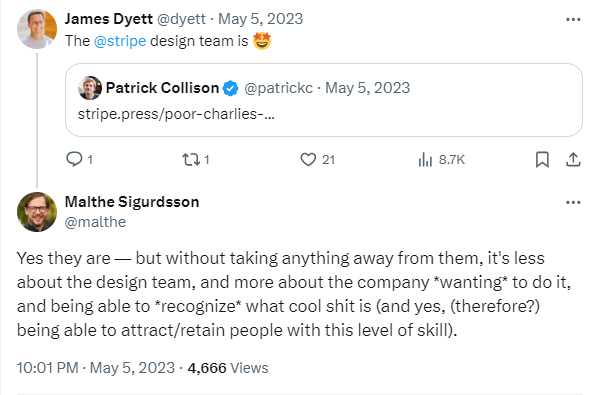With digital products, great design is not just a discipline or a process—it’s an intuition, an inherent understanding of what will resonate with users. Just as quality is essential to building enduring software, a distinct sense of style and vision is crucial to crafting digital products that stand out, delight users, and dominate markets.
Think of any digital product that you love—a product that just feels good to use, that makes your day easier or more enjoyable. Chances are, that product was built by a team that cared deeply about the details. They understood their craft and knew how to create something that wasn’t just “good enough” but was instead exceptional. They were not merely solving a problem; they were shaping an experience.
One example is hiringtool.co, a tool I co-founded to simplify candidate tracking. Instead of cluttering the interface with excessive features, we drew inspiration from familiar human behaviors like Kanban tracking, commenting, and approval workflows. HR tools are notorious for being overwhelming, despite their users' preference for user-friendly designs. By focusing on simplicity and empathy for the end-user, we created a tool that resonates deeply with its audience.

Candidates in a hiring pipeline
“Product taste is the most effective way to become AI resilient.”
When we talk about taste and “intuition” in product design, we're referring to the ability to see beyond what is simply functional or trendy. It’s about having an instinct for what feels right, knowing what users will love before they realize it themselves. This means combining insights from data and user feedback with a vision that is aesthetically pleasing, intuitive, and deeply aligned with users' needs and desires.

coming from one of the greatest music producers of all time – Rick Rubin
The cost of ignoring intuition
Over the past decade, the software industry has moved towards a more data-driven, metric-focused approach. We've built large teams that work in cycles of constant iteration, deploying new features at a rapid pace. While this has benefits, it often leads to adequate but uninspiring products. These products may “work,” but they don't evoke passion or loyalty. When the focus is solely on metrics and speed, the unique sensibility that differentiates a product is often the first casualty.
In one instance, I worked at a direct-to-consumer scooter business exploring a subscription model. There was endless internal debate about pricing, investment levels, and launch strategies. Instead of overanalyzing, I quickly designed a landing page with a form, and launched it with Google Ads. Within a single day, we collected enough leads to validate the concept, ultimately driving a strategic shift in the company towards a subscription-first model for the entire startup. This approach showcased how intuition and rapid testing could uncover lucrative opportunities faster than traditional processes.
Leadership with taste
Leadership plays a vital role in fostering a culture that values this type of creative judgment. Leaders who themselves have a refined sense of what makes a great product can inspire and guide their teams towards that vision. They prioritize hiring and promoting people who share this perspective, who think deeply about the user experience, and who are not afraid to make bold choices that may not always align with conventional metrics.
For example, when leading design teams, I often face what I call the "Why can’t we have nice things?" phase. It’s a recurring workshop where we explore inspiring products, tools, websites, and designs. Together, we ideate how those exceptional experiences could align with our customers’ needs. This phase is about raising the bar, pushing the boundaries of taste and creativity, and instilling a shared vision of excellence.

A leader with a strong vision understands that data and user feedback are essential, but they are just one piece of the puzzle. They know how to balance these inputs with their intuition and experience. They understand that a great product is not built by consensus or by blindly following the data but by a team with a clear, compelling vision guided by a strong sense of what feels right.
Tasteful teams
The solution lies in hiring and nurturing people with a strong sense of product design intuition. These individuals don’t just think about whether a product is functional but also consider how it feels, looks, and fits into the lives of its users. They are not only skilled in design but are also empathetic, intuitive, and deeply committed to creating something that feels right.
When building a team, it’s crucial to prioritize people who have this sense of vision. It’s equally important to create an environment where this kind of thinking is valued and encouraged. Too often, companies reward speed over quality and metrics over intuition. But if you want to build a product that stands out, you must foster an environment where creative judgment matters as much as data.
Listening to the market, trusting your instincts
Market signals and customer feedback are essential, but they should complement—not replace—the vision driven by intuition. Exceptional products come from a place where feedback is considered and valued, but decisions are made by people who have a refined understanding of what makes a great product.
This may sometimes mean going against the grain or making decisions that may not immediately seem obvious or backed by data. But intuition is often about trusting your sense of what will resonate with users in a way that data alone cannot predict.
Great products create advocates
Great digital products create more than just users; they create advocates and fans. These people will speak about your product at length, tweet about it, and tell their friends and colleagues that they simply must try it. When you have a great product, you don’t just have customers; you have champions.
If people aren't organically raving about your product, you might not have achieved greatness yet. A good product may serve a function, but a great product leaves a mark. It becomes part of the user’s daily life, something they feel passionate about and recommend without hesitation.
Products that are built without a guiding vision might function, but they rarely inspire. They might solve a problem, but they don’t do so in a way that makes users excited or happy. They don’t create fans; they create users who tolerate them until something better comes along.
Intuition as a competitive moat
In the end, creative judgment is the ultimate competitive advantage. It’s what differentiates your product in a crowded market. While competitors can copy features and mimic functions, they cannot replicate the unique sense of what goes into designing a truly exceptional product. That instinct, that deep understanding of what users truly want and need, becomes your moat.

In conclusion, having a keen sense of design and user experience is not just a nice-to-have in digital product design—it is essential. It's what elevates a product from good to great, from functional to beloved. To build exceptional products, hire people with this intuition, nurture it within your teams, and let it guide your vision. The market will notice, and your customers will thank you.







